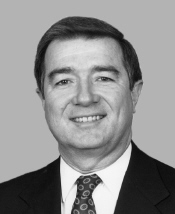Gregory Haines Laughlin(born January 21, 1942) is apoliticianfromTexas.He is a former member of theUnited States House of Representatives.
Greg Laughlin | |
|---|---|
 | |
| Member of theU.S. House of Representatives fromTexas's14thdistrict | |
| In office January 3, 1989 – January 3, 1997 | |
| Preceded by | Mac Sweeney |
| Succeeded by | Ron Paul |
| Personal details | |
| Born | Gregory Haines Laughlin[1] January 21, 1942 Bay City, Texas,U.S. |
| Political party | Democratic(before 1995) Republican(1995–present) |
| Education | Texas A&M University(B.A.) University of Texas at Austin(J.D.) |
| Military service | |
| Branch/service | United States Army United States Army Reserve |
| Years of service | 1964–1968 (reserve) 1968–1970 (active) 1970–1988 (reserve) 1991 (active) |
| Rank | Colonel |
| Battles/wars | Gulf War |
Early life and education
editLaughlin was born inBay City, Texas,and was raised inWest Columbia, Texas,where he still maintains a residence, and he graduated fromTexas A&M University.Laughlin served in theUnited States Armyfrom 1968 to 1970 and later was a reservist. Before the election to Congress in 1988, he practiced law in Texas. He served as assistant district attorney inHoustonfor four years before returning to private practice.
Election and tenure
editAconservative Democrat,Laughlin ran for theUnited States House of Representativesin 1986, narrowly losing[2]to freshmanRepublicanMac Sweeney,who had served as an aide in theRonald W. ReaganWhite House.Laughlin sought a rematch in 1988, and this time he won. Laughlin survived a bitter re-election campaign during the next cycle despite old allegations involving favoritism to a firm.
Laughlin was the only member of Congress to see active duty duringOperation Desert Storm,as acolonelin theU.S. Army Reservesin 1991.
In 1995, the Republican Party, which had gained a majority in the House for the first time in four decades, offered Laughlin a seat on theWays and Means Committeeif hejoined the GOP.Laughlin did so on June 26, 1995. He claimed that, as a Democrat, he had to make some hard votes.
In the subsequent congressional election in 1996, Laughlin was endorsed by many Republican Party leaders, including then-GovernorGeorge W. Bush,Speaker of the HouseNewt Gingrich,and other members of the party from outside the district and the state. Despite this, Laughlin faced a primary challenge from former Texas Republican CongressmanRon Paul,theLibertarian Partypresidential candidate in 1988, and Jim Deats, Laughlin's Republican opponent from 1994 (when Laughlin was still a Democrat). In the three-way race, Laughlin won the initialprimary electionwith 42 percent of the vote, but by failing to win a majority he was required to face the second-place Paul in arun-offelection. Paul defeated Laughlin by a 56–44 percent margin in therunoff electionand went on to win the congressional seat. Paul, who unsuccessfully sought the Republican presidential nomination in 2008 and 2012, held the seat until he retired in 2013.
After Congress
editLaughlin remained inWashington, D.C.,practicing law at the office ofPatton Boggs,in the areas of public policy, energy, international trade, and tax law. He has since moved to the firm of Pillsbury, Winthrop, Shaw, Pittman. Laughlin was contracted to work with the controversial Israeli spyware firmNSO Group,according to documents filed with the FARA Registration Unit of the Department of Justice.[3]The firm's software was implicated in the murder of Washington Post columnistJamal Khashoggi.[4]The software was also deployed on world leaders, journalists, dissidents and human rights activists.[5]
At the behest ofPaul Biya,Laughlin formed a bipartisan group of former members of Congress to monitor the2004 presidential elections in Cameroon.According to the BBC, he stated "we have never seen such a transparent way to show who got the vote".[6]This was in contrast to the observations of a delegation from theCommonwealth of Nationsled by former Prime Minister of CanadaJoe ClarkandEpiscopal Conference of Cameroon.[7]
See also
editReferences
edit- ^Appropriations, United States Congress House Committee on Appropriations Subcommittee on the Treasury, Postal Service, and General Government (Dec 20, 1995).Treasury, Postal Service, and General Government Appropriations for Fiscal Year 1996: Independent agencies.U.S. Government Printing Office.ISBN9780160526770.RetrievedDec 20,2020– via Google Books.
{{cite book}}:CS1 maint: multiple names: authors list (link) - ^Barone, Michael;and Ujifusa, Grant.The Almanac of American Politics1988,p. 1168.National Journal,1987.
- ^FARA Registration Unit, Department of Justice https://efile.fara.gov/docs/5198-Exhibit-AB-20210630-57.pdf
- ^"Saudis behind NSO spyware attack on Jamal Khashoggi's family, leak suggests".the Guardian.2021-07-18.Retrieved2021-07-22.
- ^Priest, Dana; Timberg, Craig; Mekhennet, Souad."Private Israeli spyware used to hack cellphones of journalists, activists worldwide".Washington Post.Retrieved2021-07-22.
- ^"Cameroon priest criticises poll".October 13, 2004.RetrievedDecember 20,2020– via news.bbc.co.uk.
- ^Wallechinsky, David (2006).Tyrants: the World's 20 Worst Living Dictators.Regan Press. pp. 286–290.ISBN9780060590048.RetrievedMarch 31,2023.
External links
edit- United States Congress."Greg Laughlin (id: L000119)".Biographical Directory of the United States Congress.
- AppearancesonC-SPAN